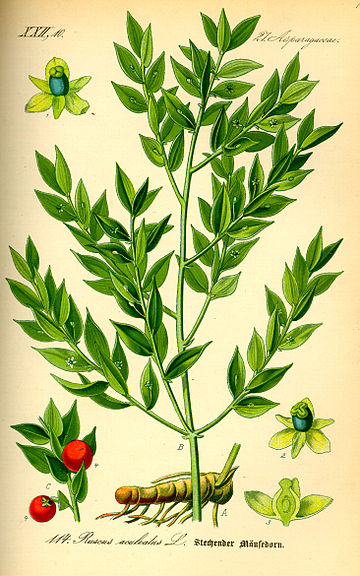Ruscus aculeatus, known as butcher's-broom, [2] is a low evergreen dioecious Eurasian shrub, with flat shoots known as cladodes that give the appearance of stiff, spine-tipped leaves. Small greenish flowers appear in spring, and are borne singly in the centre of the cladodes. The female flowers are followed by a red berry, and the seeds are bird-distributed, but the plant also spreads vegetatively by means of rhizomes. It is native to Eurasia and some northern parts of Africa. [3] Ruscus aculeatus occurs in woodlands and hedgerows, where it is tolerant of deep shade, and also on coastal cliffs. Likely due to its attractive winter/spring color, Ruscus aculeatus has become a fairly common landscape plant. [3] It is also widely planted in gardens, and has spread as a garden escapee in many areas outside its native range. The plant grows well in zones 7 to 9 on the USDA hardiness zone map. [3]
| Butcher's-broom | |
|---|---|
 | |
| Scientific classification | |
| Kingdom: | Plantae |
| Clade: | Tracheophytes |
| Clade: | Angiosperms |
| Clade: | Monocots |
| Order: | Asparagales |
| Family: | Asparagaceae |
| Subfamily: | Nolinoideae |
| Genus: | Ruscus |
| Species: | R. aculeatus |
| Binomial name | |
| Ruscus aculeatus | |
| Synonyms[1] | |
| |
The Latin specific epithet aculeatus means "prickly".[4]
History
Etymology
The common name, butcher's broom, hails from one of its original uses. In Europe, Ruscus species were traditionally harvested for their flat and stiff branches to make small brooms that were used for clearing off and cleaning butchering blocks.[5] Recent research has uncovered that butcher's broom contains some antibacterial compounds.[5] This suggests that in addition to the functional physical properties of Ruscus species, increased effectiveness in cleaning and producing safer products due to unrecognized antibacterial oils may have contributed to its popularity and subsequent nickname.
Traditional medicinal usage

Butcher's broom has been used by a variety of peoples as a treatment for a variety of ailments. A classical remedy from Europe claimed that the rhizomes could be used as a diuretic.[5] In ancient Greece, butcher's broom was used as a laxative or diuretic, and it was also believed to remove kidney stones when added to wine.[6] Butcher's broom was also used to reduce swelling and to speed the recovery of fractures.[7]
Description
Grows to length of 80 cm with stiff branches bearing cladodes (stems modified to look like leaves) and true leaves less than 5 mm. Flowers grow from axils of leaves on adaxial side of cladodes. The 6 tepals are pale green, and the ovary or stamens are violet (dioecious plant). Fruit about 1 cm red, thick and rigid. Flowers in the axil of bracts cladodes up to 4 cm. [8]
Distribution
In Great Britain it has been recorded from southern England to north Wales.[8] In north-eastern Ireland it is extremely rare growing wild but has been recorded in Counties Down and Antrim.[9]
Phytochemicals


The major phytochemicals in butcher's broom are steroidal saponins. [10] Saponins occur naturally in plants as glycosides and have foam forming properties.[11] The specific saponins found in butcher's broom are ruscogenins, ruscogenen and neoruscogenin, named for the genus Ruscus.[5] Ruscogenins function as anti-inflammatory agents[12] and are also believed to cause constriction in veins.[13] Currently the mode of action of ruscogenins is not well understood, but one proposed mechanism suggests that ruscogenins suppresses leukocyte migration through both protein and mRNA regulation.[12] Neoruscogenin has been identified as a potent and high-affinity agonist of the nuclear receptor RORα (NR1F1).[14]
Newer research has also uncovered that there are polyphenols present in butcher's broom which may also be physiologically active, possibly as an antioxidant.[15][16] As of yet there is not enough evidence to make a conclusion, but since they have now been synthesized in labs further research should be in progress.
Cultivars

The dwarf cultivar 'John Redmond', growing to 50 cm (20 in) tall by 100 cm (39 in) broad, has gained the Royal Horticultural Society's Award of Garden Merit.[17][18]
Other cultivars include 'Christmas Berry'.[19]
References
External links
Wikiwand in your browser!
Seamless Wikipedia browsing. On steroids.
Every time you click a link to Wikipedia, Wiktionary or Wikiquote in your browser's search results, it will show the modern Wikiwand interface.
Wikiwand extension is a five stars, simple, with minimum permission required to keep your browsing private, safe and transparent.
